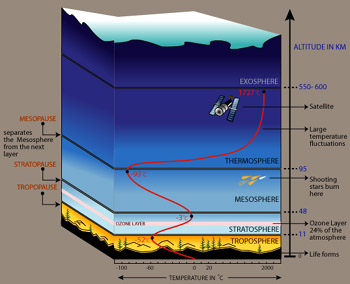|

This drawing shows the different layers
of the atmosphere. The ground is shown in brown at the bottom
of the picture. The altitude in kilometers is given on the
right hand scale and is approximate.
(Click for a
larger image.)
©
UC Regents
The Different Levels of the Atmosphere
are:
Troposphere:
This is the lowest atmospheric layer and is about seven miles
(11 km) thick. Most clouds and weather are found in the troposphere.
The troposphere is thinner at the poles (averaging about 8km
thick) and thicker at the equator (averaging about 16km thick).
The temperature decreases with altitude.
Stratosphere:
The stratosphere is found from about 7 to 30 miles (11-48
kilometers) above the Earth’s surface. In this region
of the atmosphere is the ozone layer, which absorbs most of
the harmful ultraviolet radiation from the Sun. The temperature
increases slightly with altitude in the stratosphere. The
highest temperature in this region is about 32 degrees Fahrenheit
or 0 degrees Celsius.
Mesosphere:
The mesosphere is above the stratosphere. Here the atmosphere
is very rarefied, that is, thin, and the temperature is decreasing
with altitude, about –130 Fahrenheit (-90 Celsius) at
the top.
Thermosphere:
The thermosphere starts at about 55 kilometers. The temperature
is quite hot; here temperature is not measured using a thermometer,
but by looking at the motion and speed of the rarefied gases
in this region, which are very energetic but would not affect
a thermometer. Temperatures in this region may be as high
as thousands of degrees.
Exosphere: The exosphere
is the region beyond the thermosphere.
Ionosphere:
The ionosphere overlaps the other atmospheric layers, from
above the Earth. The air is ionized by the Sun’s ultraviolet
light. These ionized layers affect the transmittance and reflectance
of radio waves. Different ioniosphere layers are the D, E
(Heaviside-Kennelly), and F (Appleton) regions.
|